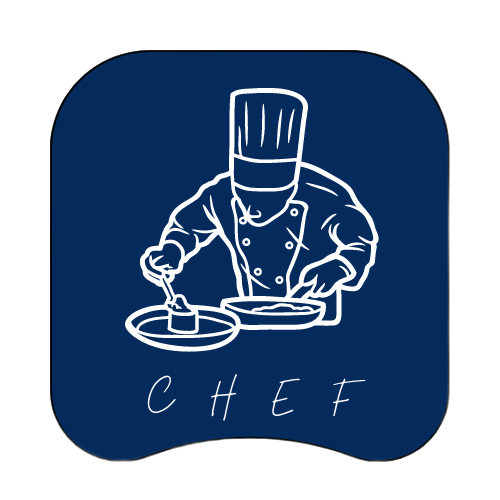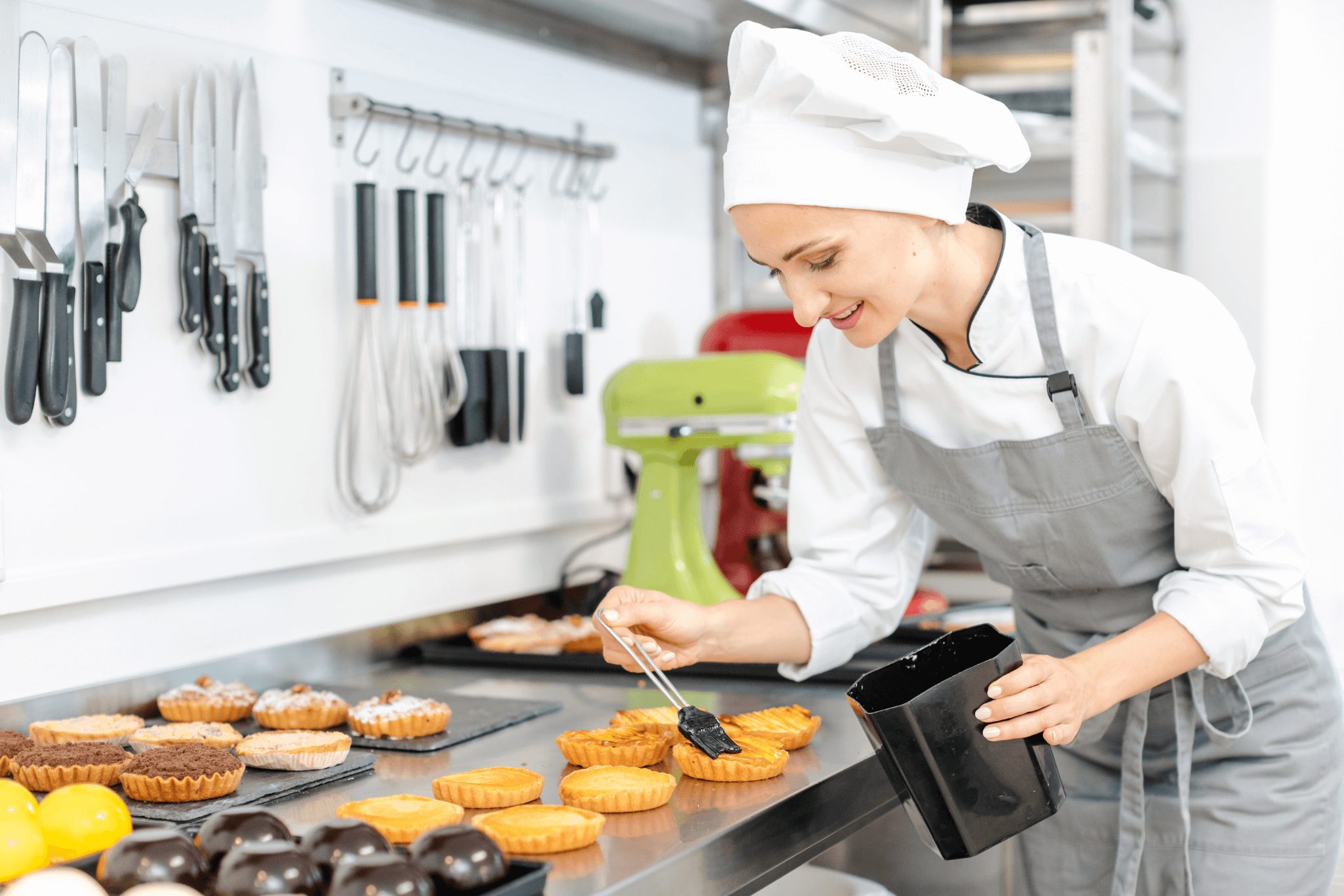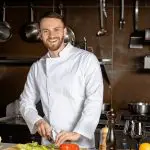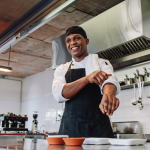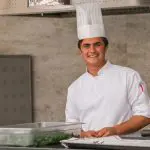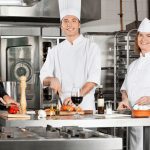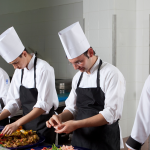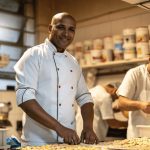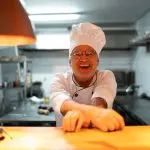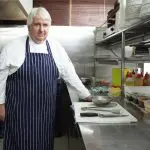Pastry chefs are the chefs who are designing and creating the desserts in a professional kitchen. Furthermore, creating other baked goods including, cookies, cupcakes, breads and working on the afternoon tea menus.
They are an essential cog in every professional kitchen.
Mainly reporting directly to the head chef with ideas and creating menus. Head pastry chefs will have their own team of chefs depending on the size and quality of the restaurant. Communicating with the chef de rang during services.
Pastry chefs train specifically on the pastry section and are well respected in any kitchen.
Want To Skip Ahead?
- Average Pastry Chef Salary
- Pastry Chef Job Description
- So Your Interested In A Pastry Chef Career
- Getting Ready To Bake
- Tips And Techniques
- Silicone Cooking Equipment
- The Core Baking Ingredients
- Traditional Afternoon Tea
- Frequently Asked Questions
A Description of the Pastry Chef Job Role?
Pastry chefs work in kitchens in hotels, restaurants, event caterers and many pastry chefs go onto running their own businesses. As a qualified pastry chef with experience, you also have the opportunity to travel all over the world.
They will need to have trained at college and experience to get a good job.
Choosing the best courses is crucial to start on the path to a successful pastry chef career. And this can be achieved at a broad age range with perseverance and hard work.
What is a Pastry chef salary
When researching how to become a pastry chef you will want to know the salary. The salary for the pastry chef will depend on the quality of the establishment. And the area the restaurant is located.
A pastry chef just starting out will be on a lower salary until they have experience behind them.
A qualified, experienced pastry chef will be on a good salary. With the highest earning pastry chefs being the chefs who have their own successful business.
Also, the pastry chef with their own business has the best opportunity to be highly successful. But will they will need to have great business skills as well as being a professional pastry chef.
An Average Pastry Chef Salary
- Apprentice: £15000 – £17000
- Experienced pastry chef: £ 20000 – £25000
- Head pastry chef: £ 35000 – £60000
- Own business chef: £35000 – £100000+
Pastry Chef Training at Schools and Colleges
To have a successful pastry chef career there are two main ways to start your path on how to become a pastry chef.
The first way is to start as an apprentice in a hotel, bistro or restaurant and work your way up the ladder when you have gained the skills and experience.
The second way is to attend a specialised pastry school and complete a professional course. Professional courses for pastry chefs will usually last for one year but can go up to three years.
Learning the Secrets From Pro Cake Decorators
It is highly recommended to attend a pastry school and the best pastry schools will have contacts within the industry, which is crucial for gaining experience and a possible job offer once finishing the course.
Having a great school behind you and a passion for becoming a pastry chef your pastry chef career will have a great foundation.
Pastry Chef Job Description
The pastry chef will be trained in making a broad range of baked foods. This may include pies, tarts, and bread all the way through to specially designed wedding cakes.
The pastry chefs have the responsibility of creating recipes, ensuring all foods are made correctly to exacting recipes they will need to do all types of baking.
Pastry chefs will generally be in charge of the whole section including managing their staff and dealing with suppliers.
Where Do Professional Pastry Chefs Work
Pastry chef jobs are mainly in busy restaurants and hotels where the pastry chef has the responsibility to create desserts and design the plating for them. Experienced chefs may also have an input into the drink suggestions that will go with the desserts.
The job may also include working within bistros and bakeries, however, this will be on a smaller scale with the pastry chefs being in charge of the baking and occasionally making specialised products.
Bakeries are usually owned by pastry chefs, and these pastry chefs will have essential management and business skills as well as being professional pastry chefs.
Where Does The Career Path Lead
A pastry chef career is a well paid, rewarding choice of career for anybody with a passion for baking and creating imaginative desserts.
With the hospitality industry growing in the UK this is also an in-demand job.
What Is The Salary Like As I Start A Pastry Chef Career
Starting on the career ladder the salary can be low even after finishing college, but with perseverance and hard work, a successful career as a professional pastry chef is possible.
When a good foundation has been laid as a pastry chef and the chef wants to be a chefpreneur then this is a great choice of career path. A chef with cooking skills and business skills can go a long way.
Pastry chefs need to learn their skills to become highly skilled at baking and desserts, and the same needs to be learned on the business side.
In the same way, the chef learns to cook they can also learn to run their own business. It is recommended to have guidance in running your own business and be prepared.
An online presence is essential for anybody starting a business today. A website is essential along with a social media presence, this can all be done cheaply when doing this yourself.
Preparation and perseverance are an essential key to success.
Pastry Chef and the Basic Training
To begin, who doesn’t love the taste, smell, and looks of a freshly baked cake? A cake makes a great addition to a family celebration such as a birthday, christening, wedding, or an anniversary.
With practice and perseverance, you can soon have a grasp of cake baking and be using your own creations for not only these special occasions but also creating cakes that can be a part of a professional catering business.
And, of course, with the right skills may be a career in baking is on your cards. Baking is without a doubt a science.
What Will I Need To Do, To Bake A Cake From Scratch?
To be able to bake a perfect cake from scratch, you will need to do the following:
- Be precise with your measuring technique.
- Pay close attention to ingredients.
- Be precise with timings and temperatures.
- Understand the chemical reactions for baking taking place.
For these reasons, baking can be a skill that regularly scares a lot of new cooks from even attempting a cake recipe. Although you will need to be scientific in your approach, cake baking is achievable by everyone.
Getting Ready to Bake
INGREDIENTS
To be able to bake the perfect cake, we need to get the ingredients correct. Always set out your ingredients before starting.
FLOUR
There is a broad range of flours and different flours will produce different characteristics to a finished cake, so use the correct flour. Always be precise with your measurements.
Scales are great; however, if you are using cups, make sure they are levelled off.
BAKING SODA OR BAKING POWDER
This ingredient should always be fresh to give a good rising of the cake and prevent a bitter taste.
SALT
Salt helps the leavening agent to activate.
DAIRY
Recipes will mainly be using dairy products. Some key points to remember here are to have any butter at room temperature before mixing it into other ingredients.
Measure any milk used precisely. Always use the correct fatness of dairy. If the recipe uses full fat, don’t use skimmed or low fat as this will affect the moisture within the cake.
SUGAR
The type of sugar used will depend on the recipe. Caster sugar will be used mainly, but brown sugars can be used too. Brown sugar will generally give a denser chewier finish.
EGGS
Eggs should also be at room temperature before mixing.
FLAVOURINGS
This is an area where it’s fine to be creative. For example, your cake recipe may ask for vanilla extract or other flavours.
Instead of the vanilla extract why not try Mexican vanilla for a more intense flavour.
TIPS AND TECHNIQUES
In most cases when you start mixing ingredients, you will always start by creaming the butter and sugars. This process will help to create a light fluffy cake texture.
The easiest way to do this is with using a stand mixer for 3–5 minutes to get the aeration needed.
Add eggs one by one, and let each one emulsify into the mixture before adding the next. Always preheat your oven as an even temperature is important to get the right results.
HOW TO TEST IF A CAKE IS BAKED
To test a cake, insert a toothpick or other clean utensil, such as a skewer, into the centre and remove. If it comes away clean, the cake is done.
You can also test a cake for doneness by lightly touching the surface. If the cake springs back into shape, you have successfully baked your own cake.
Be sure to let it cool on a wire rack before icing, trimming, or serving.
Baking Equipment
I will list some of the essential cake baking equipment tools that will be most useful in any Pastry chefs kitchen. There is a lot of cake baking equipment available. The following is a list of the basic equipment that you will find most helpful.
COOKING EQUIPMENT NEEDED By A PASTRY CHEF WHEN BAKING
When learning how to bake, remember that there is a broad range of pans; so make sure you use the correct ones. Also, many pastries can be baked in silicone moulds or by using adjustable cake rings.
BAKING TRAYS, MATS, RINGS, AND MOULDS
There is a broad range of equipment that a pastry chef will use. You should choose the correct piece of equipment for the specific job and make sure you have the correct size of rings.
Although if you only have an 8-inch ring and the recipe asks for a 9-inch ring, it will be okay to use.
However, the height of the cake will differ and the cooking time may vary slightly. All the recipes in this guide will use the same size ring or a large gastro tray. The essential equipment for a pastry chef Includes the Following:
The Gastro Tray
These trays come in a few sizes; for cooking cakes, we mainly use either a medium-depth full gastro or a medium- depth half gastro.
These size trays are good to use for a baking business. This will depend on how many portions you want to make and the size of your oven.
The tray can be lined with a baking parchment paper and the cake mixture added on top. Once the cake has cooked and cooled, it can be turned upside down, and the cake will drop out.
THE GASTRO TRAY DIMENSIONS
Full-size gastro tray — 530 mm length~ 325 mm width ~ 65 mm depth
Half-size gastro tray — 325 mm length ~ 265 mm width ~ 65 mm depth
The depth of these trays can vary. You can check these exact tray dimensions with your oven to make sure the trays will fit in correctly.
A general rule to convert the quantities: 1 large gastro tray will equal 3 spring-form rings. Or, if a recipe asks for a 20 cm ring multiply this by 3 to have the quantities for a large gastro tray.
DARIOLE MOULDS
Dariole moulds are an aluminium cylindrical mould. These moulds are used to make individual portions of desserts in a cylinder. For example, a sticky toffee pudding will often be cooked in a round cylinder shape.
This is done by using dariole moulds.
CAKE RINGS AND SQUARES
These pieces of equipment are used a lot. There are tools to make sure that all of the pieces are the exact same size to keep consistency.
There is a range of rings available to use depending on the job that is to be done.
Cakes can also be baked into other shapes including squares and rectangles. These tools are great for creating your style and developing as a pastry chef.
BAKING TRAYS
Baking trays can be found in a range of sizes. Make sure to measure your oven size and buy the correct size tray to fit in your oven. Baking trays can be used for a broad range of jobs including baking biscuits/cookies, shortbread, and brandy-snap baskets.
They are also used to place the cake rings on top of to bake the cakes in the oven. It is an essential piece of equipment in any kitchen.
SANDWICH TINS
Sandwich tins are shallow tins with a fixed bottom. I have used 20cm sandwich tins in some of the recipes further along in this guide. They are used for making thin sponges usually for layered cakes.
SILICONE COOKING EQUIPMENT
Silicone cookware is one of the most important areas of cooking tools to get to know. In professional kitchens, silicone cookware is used in almost all sections and is an essential part of any pastry section.
These tools can be used to great effect by pastry chefs.
However, many people are just starting to be aware of this type of cookware. Silicone cookware is oven, microwave, and freezer safe. They are easy to clean and can be cleaned in a dishwasher easily.
SILICONE MOULDS
Silicone moulds come in many different styles. The basic shapes include round moulds, square moulds, and rectangular moulds. Also, there are cupcake moulds, muffin moulds, and novelty moulds.
For example, to make a child’s birthday cake, a number of moulds can be used to shape the cake.
On a child’s 3rd birthday, why not make a cake in the form of the number 3, using a number 3 silicone mould.
The Novelty Moulds Used by a Pastry Chef
Teddy bear moulds are out there, too, and many other novelty moulds. If you are making a cake for Halloween, why not use a brain cake mould and develop your cake around this cake base.
I have found, even though silicone moulds are non-stick, it is always best to spray the inside of the mould with a non-stick spray.
This is a good tip if you are baking small cakes in smaller moulds, such as for a canape cake party. Looking through the range of designs is a great way to come up with new ideas for cakes.
SILICONE MATS
Another essential piece of equipment in kitchens is the silicone mat. And these mats are non-stick, and there is a range of sizes available.
They can be used in many cases instead of baking parchment paper and they are reusable, which cuts down on the cost of using baking paper.
The mats are oven, microwave, and freezer proof, and they are easily cleaned by hand or in a dishwasher.
Core Basic Baking Ingredients For The Pastry Chef
Now we will move onto getting to know the core cake baking ingredients. These core ingredients should be available at all times in a pastry chef’s kitchen.
Having these core ingredients will give you the freedom to bake whenever you feel like it.
BAKING POWDER
Baking powder is a leavening agent that combines bicarbonate of soda and cream of tartar. The cream of tartar activates the bicarbonate of soda, which creates a chemical reaction that aerates the cake.
Baking powder is often used in cake baking, but do not leave the packet open as it will deteriorate over time and lose its rising potency.
BICARBONATE OF SODA
Bicarbonate of soda is also available on its own. Bicarb is often used in cakes for a much fuller flavour. The soda creates carbon dioxide when activated, but to start the chemical reaction an acid will need to be added to the mixture.
EGGS / MARGARINE AND BUTTER
Eggs/margarine and butter are all used by pastry chefs and are a staple in most kitchens. These are fresh ingredients but are used in many areas of cooking and are good to always have in stock.
One tip here is to use what is called for in the recipe; for instance, if a recipe uses butter, don’t substitute it for margarine and vice versa. The two have different structures and are used for specific jobs.
CHOCOLATE
Having chocolate in your store cupboard is a good idea as chocolate has a lot of uses in baking. It is useful if you want to make a chocolate cake or come up with some garnishes for your cakes.
The chocolate to use should have at least 35% cocoa solids, although some recipes may require a higher percentage of cocoa.
COCOA POWDER
If you are likely to make chocolate cakes, then another staple in your cupboard needs to be cocoa powder. The strong cocoa flavour is ideal for chocolate cakes and chocolate buttercreams. Great for pastry chefs to create cakes
FLOUR
The two main types of flour used in cake baking are plain and self-raising. Both these flours are white and are a crucial ingredient in most cakes.
SUGAR
There are three main types of sugar used in pastry. These are caster sugar, icing sugar, and brown sugar (mainly a soft brown sugar is used).
For the most part, caster sugar will be used in baking. Icing sugar is a key component of cake icing and buttercreams.
The main brown sugars used in baking are the light brown sugars, such as demerara and dark, soft brown sugars such as muscovado sugar.
In addition, each type of sugar will add its own characteristics to the finished cakes.
SPICES
A range of spices can be used in cake baking including cinnamon, nutmeg, and ground ginger.
OILS
There are recipes that will call for an oil to be used. The main types of oils to be used should be mild tasting including rapeseed oil, vegetable oil, or sunflower oil.
VANILLA EXTRACT
In baking, vanilla extract is a must. used in many different recipes, such as sponges or a Chantilly cream. Real vanilla pods are a lot more expensive than the liquid vanilla extract, many pastry chefs use real vanilla pods.
However, the quality of the flavour in the finished cake will be far greater.
CANDIED PEEL
This is often used in baking. Candied peel is the peel of citrus fruits that has been sugared. It can be brought already prepared, or sugared peel can also be easily made.
DRIED FRUIT
There are many types of dried fruits that may be used. The ones to have on hand are sultanas and raisins. Other popular dried fruits include banana chips, figs, apricots, and dates.
GLACÉ CHERRIES
Glace. cherries are typically used in fruit cakes, Christmas cakes, or as a garnish (think black forest gateaux topping). These cherries have been candied.
This is the process used in a broad range of fruits that replaces the water content of fruits with sugar.
SYRUP / TREACLE / HONEY
Syrup, treacle, and honey are used in recipes and sauces. The most common syrups and treacle are golden syrup and black treacle.
Honey is also great to use in cakes, and all of these have a long shelf life.
ALMONDS
Almonds are great to be kept in stock and can be whole, flaked, or ground. I use the ground almonds in cake baking and other food styles, so they are always kept in stock.
Ground almonds can also be used as an alternative to flour in gluten-free recipes.
JAMS / APRICOT GLAZE
Jams and Glazes are needed for a range of jobs in cake baking. They can be used to spread over the sponge in a sponge cake, such as with raspberry and strawberry jam.
Apricot glaze is very good at glazing cakes — heat a little up until it is liquid and brush it over foods to give a nice glaze.
CITRUS FRUITS
Many recipes will use the zest and juice of lemons, limes, and oranges.
NUTS
The common nuts used include pecans, walnuts, hazelnuts, and flaked almonds. Substituting a different type of nut will change the taste of the cake but leave the structure of it the same.
POLENTA
Polenta is a substitute for flour in cakes. I use polenta in a polenta cake recipe, with the result being a cake that has an exciting yellow colour with a unique texture.
The Traditional English Afternoon Tea
The traditional afternoon tea is very popular in the UK. The basic set up for the afternoon tea is as follows:
- Sandwiches including the finger sandwich.
- Mini cakes.
- Scones.
- Tea.
The traditional afternoon tea will be served in a range of places with the most popular days for the afternoon tea is the weekend.
Although Saturday and Sunday are mainly the busiest times of the week for this tradition.
Also the afternoon tea can be broken down into various offerings. Champagne can be included and other extras can be added to the basic offering.
Where Can I Find The Traditional Afternoon Tea?
There are many different styles of afternoon tea that are out there. However, the basic offering may be in the local gastropub or bistro style restaurant.
And the upmarket premier afternoon tea can be found mainly at luxury five-star hotels. Also, the English afternoon tea can be prepared at home.
Building A Traditional English Afternoon Tea
Finger Sandwiches
How the finger sandwich is made.
Adding a filling to one piece of bread and placing a second piece of bread on the top. Next, the crusts will be removed carefully with a sharp serrated knife.
At this step, the sandwich is cut neatly into finger style pieces.
Traditional Fillings Can Include:
- Cream Cheese and Cucumber
- Egg Mayonnaise
- Cheese and Pickle
- Ham and Mustard.
- Smoked salmon and cream cheese
- Coronation chicken
The ingredients can range in quality and types. This may include an egg mayonnaise with some English mustard, gherkins and shallots through the mix. Or an egg and mayonnaise mix with a small amount of cress.
Mini Cakes
There is a broad range of mini cakes that may be used. Although this will depend on the quality of the venue and the chosen menu. However, a luxury five-star hotel in central London will mainly have all mini cakes prepared and made in-house to a high standard.
With the pastry chef coming up and using concepts in design with a great deal of thought going into each cake. To produce stunning looking cakes with great flavours.
Scones
The scone is also part of the traditional English tea. Mainly one portion will make up of one plain scone and one fruit scone. Scones will either be brought in from a supplier or freshly made in-house. Depending on the skills of the kitchen team.
The Tea
Many types of tea are served with the afternoon tea selection. With the standard places using a choice of basic teas including, earl grey.
And also, the more specialised offering a serving with a selection of teas that may include a choice from a tea cellar:
- Black teas,
- green teas,
- white teas
- herbal teas.
Champagne
And also, for an extra added treat you could choose a champagne afternoon tea option.
Conclusion
The traditional English afternoon tea is a very classic English dish. At least once in your life, you should experience a full-on, all guns blazing offering at one of the top places in the UK.
In addition to the food, there’s also a great charm and elegance about the whole ritual.
And also the foods will be way above the offerings at the average places. However, there is an afternoon tea option to suit most tastes. Or why not make a traditional afternoon tea at home for a special occasion.
How to become a dessert chef?
Do you a passion for making desserts and enjoy making bread and cakes. Today is the right time to get yourself into a well paid and rewarding job as a pastry chef.
The industry is growing and pastry chefs are in need.
Frequently asked Questions For The Pastry Chef Role
What Are Some Responsibilities Of A Pastry Chef?
Pastry chefs focus on preparing desserts, pastries and baked goods. Their responsibilities include recipe creation, preparing ingredients, baking and decorating and keeping the presentation standards at a high level.
Essential Skills For The Pastry Chef Role
- Skilled in a range of baking techniques
- Artistic and creative skills in decorating
- Attention to detail
- Knowledge of food hygiene
- Capable of multitasking and time management
- Capable of working under pressure
What Qualifications Or Experience Are Required
- Formal training, specialisation in pastry preferred
- Work experience in a bakery, patisserie, or restaurant
- Expertise in understanding ingredients and using baking tools
Whats The Difference Between A Pastry Chef And A Regular Chef
The pastry chef focus is exclusively on the desserts, pastries and baked goods from the menu. The pastry chefs typically work in a separate part of the kitchen.
A Day In The Life Of A Pastry Chef
- Planning and preparing the dessert menu
- Measuring and mixing ingredients
- Creating the menu items and adjusting recipes as needed
- Plating and presenting desserts
- Keeping the workspace clean and organised
Common Challenges Of A Pastry Chef
- Managing time sensitive processes like proofing and baking
- Responsibility for intricate desserts and maintaining consistency
- Managing stock for perishable ingredients
- Balancing creativity with customer preferences and costs
What Career Progression Opportunities Exist
- Executive pastry chef, or head of a pastry department
- Opening a bakery or patisserie shop
- Transition into a teaching or consulting role
- Competing in or judging culinary competitions
What Is The Pastry Chef Salary Expectations?
Salaries depend on establishment and location. For up to date salaries try these websites;
(caterer.com)
(talent.com)
(Totaljobs.com)
The Working Conditions Of A Dessert Chef
- Often starting early in the morning to prepare fresh baked goods
- Involves long hours standing and working in a fast paced environment
- Attention to precision is critical to dessert creation
How Important Is Creativity For A Pastry Chef?
Creativity is essential for the creation of innovative desserts, flavour combinations and stunning designs. A pastry chef’s ability to create visually stunning items can set them apart in the industry.
